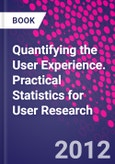The book discusses ways to quantify user research; summarize data and compute margins of error; determine appropriate samples sizes; standardize usability questionnaires; and settle controversies in measurement and statistics. Each chapter concludes with a list of key points and references. Most chapters also include a set of problems and answers that enable readers to test their understanding of the material. This book is a valuable resource for those engaged in measuring the behavior and attitudes of people during their interaction with interfaces.
Table of Contents
DedicationAcknowledgements
About the Authors
1. Introduction and How to Use This Book
2. Quantifying User Research
3. How Precise Are Our Estimates? Confidence Intervals
4. Did We Meet or Exceed Our Goal?
5. Is There a Statistical Difference between Designs?
6. What Sample Sizes Do We Need?
Part 1: Summative Studies
7.�What Sample Sizes Do We Need?
Part 2: Formative Studies
8. Standard Usability Questionnaires
9. Six Enduring Controversies in Measurement and Statistics
10. Wrapping Up
Appendix
Index
Authors
Jeff Sauro Usability Metrics and Statistical Analyst, Measuring Usability LLC, CO, USA.Dr. Jeff Sauro is a six-sigma trained statistical analyst and founding principal of MeasuringU, a customer experience research firm based in Denver. For over fifteen years he's been conducting usability and statistical analysis for companies such as Google, eBay, Walmart, Autodesk, Lenovo and Drobox or working for companies such as Oracle, Intuit and General Electric.
Jeff has published over twenty peer-reviewed research articles and five books, including Customer Analytics for Dummies. He publishes a weekly article on user experience and measurement online at measuringu.com.
Jeff received his Ph.D in Research Methods and Statistics from the University of Denver, his Masters in Learning, Design and Technology from Stanford University, and B.S. in Information Management & Technology and B.S. in Television, Radio and Film from Syracuse University. He lives with his wife and three children in Denver, CO.
James R Lewis Senior Human Factors Engineer, IBM, FL, USA.
Dr. James R. (Jim) Lewis is a senior human factors engineer (at IBM since 1981) with a current focus on the measurement and evaluation of the user experience. He is a Certified Human Factors Professional with a Ph.D. in Experimental Psychology (Psycholinguistics), an M.A. in Engineering Psychology, and an M.M. in Music Theory and Composition. Jim is an internationally recognized expert in usability testing and measurement, contributing (by invitation) the chapter on usability testing for the 3rd and 4th editions of the Handbook of Human Factors and Ergonomics, presenting tutorials on usability testing and metrics at various professional conferences, and serving as the keynote speaker at HCII 2014. He was the lead interaction designer for the product now regarded as the first smart phone, the Simon, and is the author of Practical Speech User Interface Design.
Jim is an IBM Master Inventor Emeritus with 88 patents issued to date by the US Patent Office. He serves on the editorial board of the International Journal of Human-Computer Interaction, is co-editor in chief of the Journal of Usability Studies, and is on the scientific advisory board of the Center for Research and Education on Aging and Technology Enhancement (CREATE). He is a member of the Usability Professionals Association (UPA), the Human Factors and Ergonomics Society (HFES), the ACM Special Interest Group in Computer-Human Interaction (SIGCHI), past-president of the Association for Voice Interaction Design (AVIxD), and is a 5th degree black belt and certified instructor with the American Taekwondo Association (ATA).








